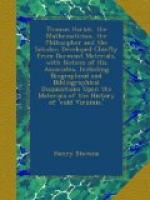But time and space beckon. On the 24th of March 1603, set ’that bright occidental Star,’ and ’ that mock Sun’ fræ the north took by succession its place. To Raleigh the change was the setting of a great hope, for to Queen Elizabeth he owed his fortunes, and was proud of the debt. To Raleigh more than to any other one man, notwithstanding his many faults, the Queen owed the brilliancy of her Court, the efficacy and terror of her navy, the enterprise and intelligent energy of her people, to say nothing of the adventurous spirit of colonization which he awoke in his efforts in Western Planting. The glory of his achievements today is the glory alike of England and English America. King James let no man down so far as he did Raleigh. Perhaps it was because there was no one left of Elizabeth’s Court who could fall so far.
On three trumped up charges which never were, and never could be sustained with due form of law, Raleigh was with small delay thrown into the Tower. Several other noblemen and less eminent persons were sent there also. The Asiatic plague was raging in the City. A moral pestilence of equal virulence at the same time infested the Court. The State prisoners must be tried openly, though already secretly condemned. The Judges of his ’ dread Majesty’ dared not venture to the Tower as usual for the trials, forgetting apparently that its precincts were just as unhealthy for the great prisoners of State as for them, who were liable any day on the miffs of majesty to change places.
So it was determined that the’ traitors’ should be carted down to Winchester for trial. A cold wet November seven-days’ journey through mud and slush was the miserable dodge to carry out this scheme of darkness which neither Coke nor Popham would have dared to perpetrate in the broad light of London. It was, as all the world knows, a mock trial. The prisoners Raleigh, Cobham, Gray, and Markham were condemned and sentenced to death as traitors, and Raleigh, for the grim sport of the royal Nimrod, was made to witness a mock execution of his fellow-convicts, but being in due course all respited by a warrant which the Governorof Winchester Castle had carried three days in his pocket, were carted back to the Tower, where, not pardoned, their sentences not commuted, but simply deferred, they were tortured with a living death hanging over them, like the sword of Damocles depending on royal caprice.
Here Raleigh dragged out his long imprisonment, and (as tersely & truly expressed by his son) was, after thirteen years, beheaded for opposing the very thing he was condemned and sentenced for favouring. The whole story is a bundle of inconsistencies, like that of Henry Percy, the 9th Earl of Northumberland, committed to the Tower in 1606, and his fifteen years’ imprisonment. The stories of these two celebrated men are inseparably connected with that of Hariot. But it is not our purpose to trace either Raleigh’s or Percy’s progress through these long and dreary years any further than is necessary to illustrate the life of Hariot, who was the light of the outer world to them both. Incarcerated and watched as they were, Hariot was the ears, the eyes, and the hands of these two noble captives.




